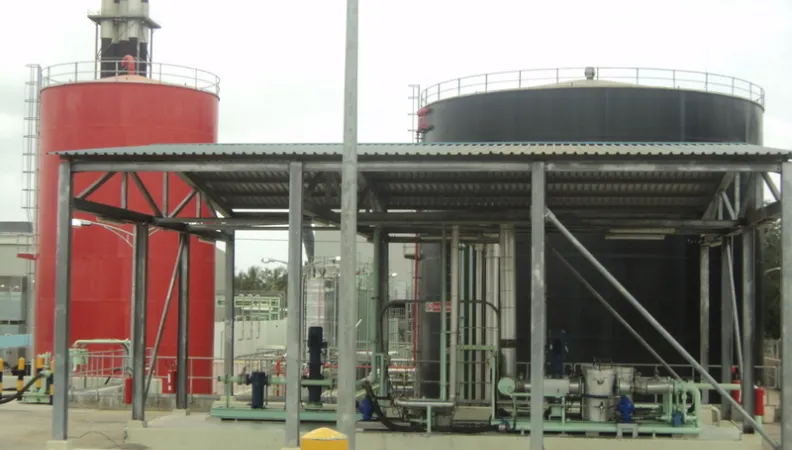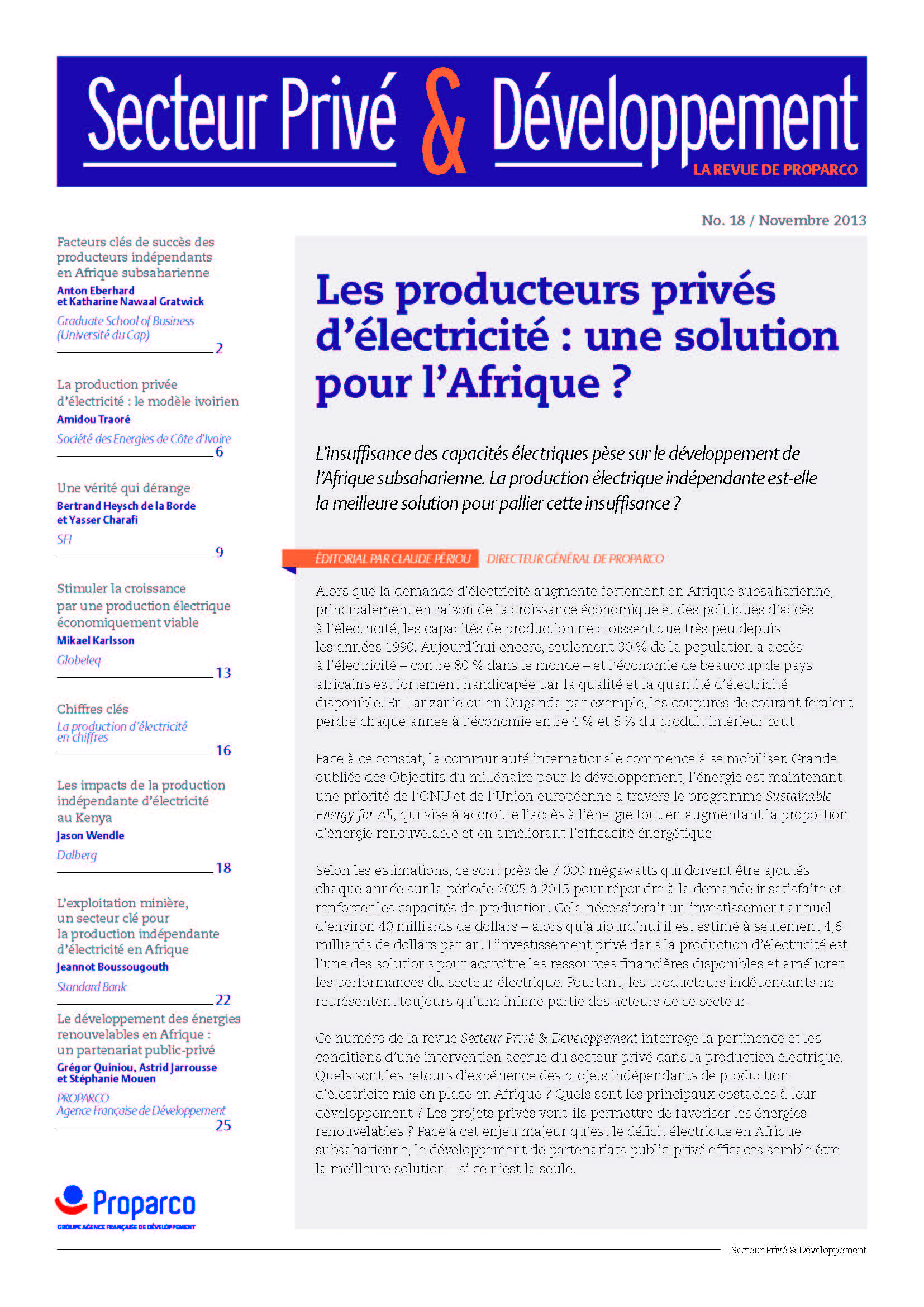Share the page
Independent power generation: the Ivoirian model
Published on
Amidou Traoré Chief Executive Société des Energies de Côte d’Ivoire


Private Sector & Development #18 - Independent power producers: a solution for Africa?
This issue explores the benefits and the requirements of increased intervention in electricity production by the private sector. Developing efficient public-private partnerships would seem to be the best solution for confronting the major challenge of sub-Saharan Africa’s energy deficit.
Côte d'Ivoire was one of the first countries in sub-Saharan Africa to privatise its electricity sector and, today, independent producers play a significant role in the country's electricity generation. The country is now willing to prioritise hydroelectric projects, in order to balance the energetic mix. Yet, as demand grows, the private sector still offers substantial potential for independent operators.
Côte d'Ivoire was the first sub-Saharan Africa nation to turn to the private sector to expand its electricity generation capacity when the government, on top of opening up electricity production to competition, established Compagnie Ivoirienne de l'Électricité (CIE) in 1990, granting it a concession covering the purchase, transmission and distribution of electricity. A second restructuring phase was launched in 1998 – this time primarily focused on making the sector more profitable. A last reform was launched in 2011, when the state-owned company Société des Énergies de Côte d'Ivoire (CI-ENERGIES) was created to plan and manage investments in the power sector (see Box).
The structure of Cote d'Ivoire's electricity sector
The company Énergie Électrique de Côte d'Ivoire (EECI), established in 1952, has historically been responsible for implementing government policy relating to electricity and water. The law of 29 July 1985, governing the generation, transmission and distribution of electricity, opened up the production sector in Côte d'Ivoire to private operators – expanding it to cover all authorised energy sources.Present-day government organisations include Société des Énergies de Côte d'Ivoire (CIENERGIES), responsible for managing assets in the electrical sector and planning and contracting investments, and the regulatory body Autorité Nationale de Régulation du Secteur de l'Électricité (ANARE). Compagnie Ivoirienne d'Électricité (CIE), the electricity sector operator, is a private company – as are the independent producers CIPREL, Azito, Aggreko and the natural gas producers (AFREN, Foxtrot, Canadian Natural Resources).
Private sector involvement in Côte d'Ivoire's electricity industry is not limited exclusively to power generation. The government has set in place an innovative model based on contracting the operation of the entire sector to a private company. Begun 1998, this model instigated a system of cascading payments for all producers – a key source of security for independent power producers (IPPs). This model enabled private and public power generation to continue even throughout the political crisis of 2010–2011. At the official opening of the Aggreko thermal power plant in July 2013, Côte d'Ivoire's prime minister stated that his country's aim was to double its power generation capacity by 2020. This impressive increase in capacity, a response to growing demand, cannot, however, be achieved without the involvement of the private sector.
The private sector's growing share of power generation
The oil crises of 1973 and 1979 reaffirmed Côte d'Ivoire's decision to prioritise hydroelectric power production – dams at Kossou (174 MW), Taabo (210 MW) and Buyo (165 MW) became operational in 1972, 1979 and 1980 respectively. As a result, Énergie Électrique de la Côte d'Ivoire (EECI), the national company responsible for investment and operations, was able to fulfil more than 80 per cent of the national demand for electricity at a relatively low cost in years of good rainfall conditions. The drought of 1983–1984, however, forced Côte d'Ivoire to rebalance its energy mix. In consequence, EECI urgently commissioned a 100 MW gas turbine power plant at Vridi, but the increase in production costs from this led to a financial deficit that dogged EECI until 1990. That year Côte d'Ivoire decided to privatise its electricity sector, created CIE and contracted this new organisation for the national generation, transmission, distribution, export and import of electrical energy – with the aim of ensuring the sector's financial recovery. EECI remained in charge of planning and contracting investments. By 1994 demand for electrical energy had increased significantly, driven by the economic recovery that followed the devaluation of the CFA franc. Thus the risk of load-shedding and a lack of government funds prompted Côte d'Ivoire, to turn to IPPs to boost the country's capacity. On 20 July 1994 an agreement was signed with Compagnie Ivoirienne de Production d'Électricité (CIPREL) for the construction, operation and eventual transfer of ownership of a 200MW thermal power plant, and then in September 1997, a contract was concluded with Azito Énergie for the development of a 300MW natural gas-fired power plant in Azito. The installed capacity of these IPPs has been increased and the agreements have been extended several times – in 1997, 2010 and 2011 for CIPREL and in 1999, 2000 and 2013 for Azito. Turning to IPPs in this way gave Côte d'Ivoire access to the electricity it needed to meet growing national demand. Private production has enabled the country to respond rapidly to demand while also positioning itself as a net exporter of electricity to other countries within the sub-region (Benin, Burkina Faso, Ghana, Mali and Togo). This positioning has been strengthened by the development of IPPs, highly reliable and presenting better availability rates. The figures for 2012 show total gross production of 6,949 GWh, energy exports of 610 GWh and a peak of 1,006 MW on the grid. The national coverage rate - the number of localities with access to electricity as a proportion of total localities - is 34 per cent while the access rate - the population living in localities with access to electricity as a proportion of the total population - is 74 per cent. This public-private partnership has also had the advantage of reducing national debt in the electricity production sector.
Key success factors and limitations
Overall Côte d'Ivoire's experience of using the private sector for electricity generation is a positive one. Several key success factors emerge from this experience. First of all it should be noted that payments to IPPs, which are collected by CIE, are secured by a law governing funding allocation in the Ivoirian electricity sector, with payments to IPPs prioritised in the management of financial flows. This arrangement has continued to function even in a crisis situation, thus allowing IPPs to continue to supply the power and energy necessary to cover demand. The purchasing of the generated energy is governed by take-or-pay contracts1, which guarantee the private producer sufficient revenues to make the project profitable, in accordance with the business plan produced as part of the feasibility study. Finally, IPPs enjoy attractive tax incentives – in the form of tax exemption on their trading profits for several years – as well as various preferential customs tariffs. Even so, this model does involve some constraints. Take-or-pay commitments included in the contracts lead to inflexibility in the management of generation facilities. The effect is that energy produced by the IPPs has to be purchased as a priority, an arrangement that can be cumbersome when it comes to developing a least cost development plan. A production base consisting only of IPPs with take-or-pay contracts is not a viable option as it would hamper the entire electricity generation system and put the grid security at risk. In order to reduce their financial, operational and commercial risks, IPPs investors and their funders require a high level of involvement from the state through comfort letters and various securities. This is sometimes regarded as excessively onerous from the public sector perspective. Direct state investment in transmission and distribution infrastructure is required, too. Moreover, relatively long time scales are required for initiating private projects and securing their financing – these processes can extend over several months due to the legal requirements exacted by funders. It is also worth noting some unsuccessful experiences: agreements signed with private developers who were subsequently unable to secure a construction contract or adequate funding, as a result of which the agreements had to be terminated. Thus, the key success factors of private electricity generation are mainly the institutional framework, the support of the public sector, the choice of reliable operators and the sustainability of the projects.
A sector with significant potential
Côte d'Ivoire's installed capacity of 1,421 MW at 1 January 2013 is set to increase to 1,632 MW by the end of 2013 with the commissioning of Aggreko's 100 MW power station and the first phase of the CIPREL 4 project with a capacity of 111 MW. The country's aim is to double its early 2013 installed capacity by 2020 (Figure 1), with priority being given to hydroelectric projects, which generate renewable and less expensive energy, in the scheduling of medium- and long-term facilities. In order to develop this type of large-scale project, the government is willing to set up financing mechanisms based on public-private partnerships. In this context, the government has committed to rebalancing Côte d'Ivoire's electricity sector financially and to strengthen its investment capacity. This commitment of the state is reflected in the Strategic Action Plan developed by the Ministry of Petroleum and Energy of Côte d'Ivoire.
The use of IPPs ensures that demand growth can also be met. Of the 1,500 MW of new projects that the country plans to commission by 2020, hydroelectric and thermal power plants developed by private operators accounts for around 85%. The government's goal of developing a balanced energy mix should encourage private hydroelectric production as well as the use of new and renewable sources of energy. The new Master Plan 2013-2030 which is currently in progress will explore all sources of potential production in Côte d'Ivoire. Besides, new laws that are about to be passed reflect this ambition of encouraging private sector initiatives, by defining a new regulatory framework for future investment in the sector. Finally, the energy requirements generated by large-scale projects (in the mining industries, for example) will increase the need for power. Côte d'Ivoire therefore offers significant potential for the development of independent electricity production.
1 Take- or- pay: a clause in an electricity power purchase agreement by which the seller guarantees to supply the electricity to the buyer and the buyer guarantees, in return, to pay for a minimum quantity of energy, whether or not the buyer takes delivery of this that amount.

